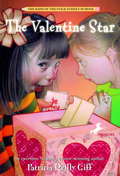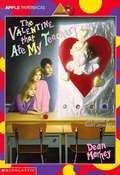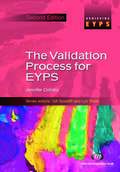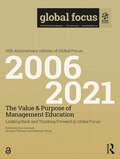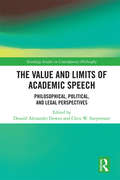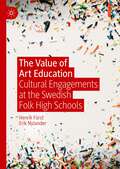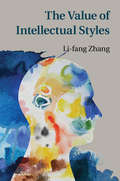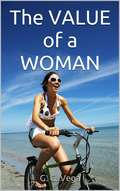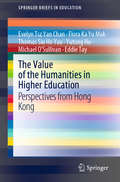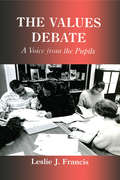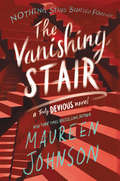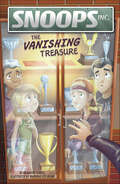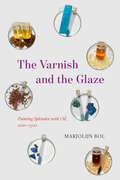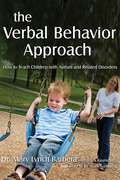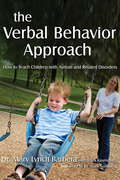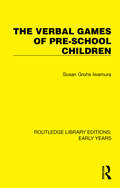- Table View
- List View
The Valentine Generation and Other Stories (Structural Readers)
by John UpdikeAn anthology of short stories from John Updike, John Wain, Doris Lessing, Frank Tuohy, H. E. Bates, and Elizabeth Taylor. After the stories are exercises in comprehension and structure.
The Valentine Star (Kids of Polk Street School #6)
by Patricia Reilly Giff Blanche SimsIt's time for everyone in Ms. Rooney's room to make cards for the Valentine box. Emily Arrow couldn't be happier when Dawn Bosco gives her some colored stars to decorate her cards. She plans to make a special one for Ms. Vincent, the new student teacher.<P><P> But things take a turn for the worse when Ms. Rooney asks Emily to be class monitor. Emily feels important sitting at the teacher's desk, until Sherri Dent leaves her seat without Emily's permission. Emily reports her. That's when Sherri tells Emily, "You'll be sorry." <P> Emily is really worried. What will Sherri do to get even?
The Valentine That Ate My Teacher
by Dean MarneyBefore you can say "Be Mine", Lizzie, Scott, Sybil, and their substitute teacher, Mr. Bernstein, are sucked into the class Valentine Box and swept to another world!
The Valentine's Day Disaster
by Brandi Dougherty[from the back cover] "There's one thing Maddy loves: SOCCER. And there's one thing Maddy doesn't love: VALENTINE'S DAY. So what happens when the two collide? DISASTER, THAT'S WHAT! When Maddy's soccer league fund-raiser is cancelled so the student council can throw a Valentine's Day Dance, Maddy is furious. She's ready to boycott the dance! Maddy soon realizes, though, that everyone wants to go to the dance, including her BFF Sarah and her super-popular (and super-annoying) older sister Monica. It's one hilarious disaster after another as Maddy tries to save the soccer fundraiser and her friendship (and, by the way, why is Maddy's cute friend Josh acting so weird around her?)!"
The Validation Process for EYPS (Achieving EYPS Series)
by Jennifer CollobyThis book supports all candidates for Early Years Professional Status (EYPS) as they prepare for the Validation Process. Through a series of reflective activities based on case studies of successful candidates, this book helps those on the EYP pathway prepare for assessment and build confidence in their own good practice and skills. This second edition incorporates the changes to the assessment requirements introduced in September 2008 and references the new Candidate′s Handbook.
The Value & Purpose of Management Education: Looking Back and Thinking Forward in Global Focus
by Eric CornuelWithout a doubt, business schools have been a success story in higher education over the last 50 years (the period of EFMD’s existence). Even so, they have come under scrutiny, and attack, over their academic legitimacy and value proposition for business and society. In this book, drawn from a special issue of Global Focus, the EFMD has selected around 25 of the best, most thoughtful short papers published in Global Focus to examine the role and purpose of EFMD in the evolution of management education. Each of the chapters interpret current strategic debates about the evolution of business schools and their paradigms and also identify possible strategic options for handling uncertain, volatile futures. These papers can be broadly categorized into four consistent themes: the first theme is concerned with the purpose and value proposition of management education; the second theme focuses on a perceived need for new business models and how to design and build them; the third theme addresses the question of the impact of the business school on business and society given the increasingly academic pursuits of business schools and their often weak links to the business community – the so-called rigour/relevance dilemma; and the fourth theme concerns how to ‘map’ and design business school futures in an increasingly volatile, uncertain, complex and ambiguous crisis-oriented environment. This impressive collection of insights from business management leaders from across the globe is inspiring reading for higher education leaders, policy makers and business leaders seeking insight into the future of management education.
The Value and Limits of Academic Speech: Philosophical, Political, and Legal Perspectives (Routledge Studies in Contemporary Philosophy)
by Donald Alexander Downs Chris W. SurprenantFree speech has been a historically volatile issue in higher education. In recent years, however, there has been a surge of progressive censorship on campus. This wave of censorship has been characterized by the explosive growth of such policies as "trigger warnings" for course materials; "safe spaces" where students are protected from speech they consider harmful or distressing; "micro-aggression" policies that often strongly discourage the use of words that might offend sensitive individuals; new "bias-reporting" programs that consist of different degrees of campus surveillance; the "dis-invitation" of a growing list of speakers, including many in the mainstream of American politics and values; and the prominent "shouting down" or disruption of speakers deemed inconsistent with progressive ideology. Not to be outdone, external forces on the right are now engaging in social media bullying of speakers and teachers whose views upset them. The essays in this collection, written by prominent philosophers, political scientists, sociologists, and legal scholars, examine the issues at the forefront of the crisis of free speech in higher education. The contributors address the broader historical, cultural, legal, and normative contexts of the current crisis, and take care to analyze the role of "due process" in protecting academic freedom and individuals accused of misconduct. Additionally, the volume is unique in that it advances practical remedies to campus censorship, as the editors and many of the contributors have participated in movements to remedy limitations on free speech and open inquiry. The Value and Limits of Academic Speech will educate academic professionals and informed citizens about the phenomenon of progressive censorship and its implications for higher education and the republic.
The Value of Art Education: Cultural Engagements at the Swedish Folk High Schools (Sociology of the Arts)
by Erik Nylander Henrik FürstThis book shows the continuing importance of art education. Art education attracts students who see multiple meanings and justifications for the worth of that education. Their engagement in art education is not limited to the uncertain prospects for jobs or routes into employment in the arts. Fürst and Nylander approach art education through a rich array of empirical examples derived from Swedish folk high school programs in music, visual arts, and creative writing. Based on an analytical framework of pragmatic sociology, the book allows the reader to understand the competences and critical capacities held by students and teachers. The book challenges the dominant public perception of art education and broadens our understanding of what it is good for. The Value of Art Education is essential reading for those defending the status of this vital sector of education, offering a deeper understanding of why people engage, what they gain, and the social importance of the arts.
The Value of Drawing Instruction in the Visual Arts and Across Curricula: Historical and Philosophical Arguments for Drawing in the Digital Age (Routledge Research in Arts Education)
by Seymour Simmons IIIBy applying philosophical and historical perspectives to drawing instruction, this volume demonstrates how diverse teaching methods contribute to cognitive and holistic development applicable within and beyond the visual arts.Offering a new perspective on the art and science of drawing, this text reveals the often-unrecognized benefits that drawing can have on the human mind, and thus argues for the importance of drawing instruction despite, and even due to contemporary digitalization. Given the predominance of visual information and digital media, visual thinking in and through drawing may be an essential skill for the future. As such, the book counters recent declines in drawing instruction to propose five Paradigms for teaching drawing – as design, as seeing, as experience and experiment, as expression, and as a visual language – with exemplary curricula for pre-K12 art and general education, pre-professional programs across the visual arts, and continuing education. With the aid of instructional examples, this volume dispels the misconception of drawing as a talent reserved for the artistically gifted and posits it as a teachable skill that can be learned by all.This text will be of primary interest to researchers, scholars, and doctoral students with interests in drawing theory and practice, cognition in the arts, positive psychology, creativity theory, as well as the philosophy and history of arts education. Aligning with contemporary trends such as Design Thinking, STEAM, and Graphicacy, the text will also have appeal to visual arts educators at all levels, and other educators involved in arts integration.
The Value of Intellectual Styles
by Zhang Li-FangIntellectual styles are individuals' preferred ways of using their abilities. This book provides the first comprehensive and systematic review of existing research on the value and desirability of different intellectual styles. By critically analyzing findings from hundreds of international studies undertaken over eight decades, Li-fang Zhang demonstrates that the creativity-generating Type I styles are generally superior to the norm-conforming Type II styles in relation to a wide range of learning processes and developmental outcomes, work performance, physical and mental health, and many other domains of people's lives. She further demonstrates that people explicitly and implicitly express their preference for Type I styles over Type II styles. Professor Zhang elucidates the practical value of cultivating diverse intellectual styles, especially Type I styles, in both academic and nonacademic settings, and lays the groundwork for future research to advance the field of intellectual styles and to inform scholarly work in other academic disciplines.
The Value of TVET in Advancing Human Development and Reducing Inequalities: The Case of Palestine (Technical and Vocational Education and Training: Issues, Concerns and Prospects #37)
by Randa HilalThis book examines the contribution of Vocational Education and Training to advancing human development and reducing inequality. It uses the example of Palestine as case-study rich in multi-layered inequalities, some of which are experienced in the region and worldwide, while others are specific to adverse conditions. The case of Palestine provides fertile ground for understanding inequality and human development, and for echoing the developed knowledge through to the understanding of Vocational Education and Training and Human Development globally. The book brings original theoretical approaches, evidence of the value of Vocational Education and Training, and contributes to academic debates, as well as provides empirical evidence for practitioners and donor community.
The Value of a Woman
by G. G. Vega Ana Vanessa Alves TorreBut, the man, he did not feel complete, he lacked something, but no, ... it was someone, he did not know, but God did. He was missing a girl, a woman, and it would be called EVA. There was a space in his new world, that nothing filled, created, living and non-living things were not enough. And God knew it. I did not know, I did not understand, I could not interpret his lack, that kind of emptiness within his time and space, his existence. But the Creator did know. He understood that he lacked a company, but not any company, he had to be the complement, that which would complete his existence, that which would allow him to enjoy life. Someone who filled his emptiness, his loneliness in the face of such abundance, someone who would give another meaning to his existence, and was not someone who would only accompany him, come to help him, to be a complement, to form a team.
The Value of the Humanities in Higher Education: Perspectives from Hong Kong (SpringerBriefs in Education)
by Eddie Tay Michael O'Sullivan Evelyn Tsz Chan Flora Ka Mak Thomas Siu Yau Yutong HuThis book presents an extensive analysis of the multifaceted benefits that higher education in the humanities offers individuals and society, as explored in the context of Hong Kong. Using both quantitative graduate employment survey data and qualitative data from interviews with past humanities graduates and with leading humanities scholars, the study provides an objective picture of the “value” of humanities degrees in relation to the economic needs and growth of Hong Kong, together with an in-depth exploration of their value and use in the eyes of humanities graduates and practitioners. Therefore, although it is hardly the only book on the value and status quo of the humanities worldwide, it nonetheless stands out in this crowded field as one of the very few extended studies that draws on empirical data.The book will appeal to both an academic and a wider audience, including members of the general public, non-academic educators, and government administrators interested in the status quo of humanities education, whether in Hong Kong or elsewhere. The report also includes a wealth of text taken directly from interviews with humanities graduates, who share their compelling life stories and views on the value of their humanities education.
The Values Book: Teaching 16 Basic Values to Young Children
by Pam Schiller Tamera BryantYoung children learn best by doing, and that includes learning values. The Values Book is packed with easy activities, projects and ideas to help children learn values and build character, both individually and in groups. Each chapter addresses one of 16 different values, including understanding, patience and tolerance. After defining the value, each chapter begins with questions to help adults clarify what that value means to them. The perfect book to introduce and strengthen the teaching of values in any early childhood classroom or home.
The Values Debate: A Voice from the Pupils (Woburn Education Series)
by Leslie J. FrancisPresents findings from a survey conducted among 30,000 13-15 year olds throughout England and Wales, giving particular attention to social, personal and moral issues.
The Values of Educational Administration: A Book of Readings
by Paul T. Begley Pauline E. LeonardValues and ethics have traditionally been considered an important influence on administrative practices, and are typically included as a component of core courses in department of educational administration in the US, Canada and Australia. The recent resurgence of interest among practitioners in the topic of values and ethics as a guide to action increases the importance and appeal of this book of readings. This comprehensive book extends beyond the presentation of 'expert opinion' and appeals to an audience of academics and practitioners working at the policy level of educational organisations. Theory building, policy applications and praxis are addressed in this highly adoptable book by leading scholars in the field.
The Values of Literary Studies
by Rónán McdonaldWhat is valuable about literary studies? What is its point and purpose? In The Values of Literary Studies: Critical Institutions, Scholarly Agendas, leading scholars in the field illuminate both the purpose and priorities of literary criticism. At a time when the humanities are increasingly called upon to justify themselves, this book seeks to clarify their myriad values and ideologies. Engaging the idea of literary value while at the same time remaining attuned to aesthetic, ethical, political and psychological principles, this book serves to underscore the enduring significance of literary studies in an academic climate that is ostensibly concerned with expediency and quantification. As a sophisticated examination of literary theory and criticism, The Values of Literary Studies: Critical Institutions, Scholarly Agendas provides a comprehensive and hopeful view of where the discipline is now and what avenues it is likely to take from here.
The Van and the Hot Rod (Primary Phonics Storybook #Set 1A Book 3)
by Barbara W. MakarA systematic, phonics-based early reading program that includes: the most practice for every skill, decodable readers for every skill, and reinforcement materials--help struggling students succeed in the regular classroom
The Vanishing Stair (Truly Devious #2)
by Maureen JohnsonIn New York Times bestselling author Maureen Johnson’s second novel in the Truly Devious series, there are more twists and turns than Stevie Bell can imagine. No answer is given freely, and someone will pay for the truth with their life. <P><P>The Truly Devious case—an unsolved kidnapping and triple murder that rocked Ellingham Academy in 1936—has consumed Stevie for years. It’s the very reason she came to the academy. But then her classmate was murdered, and her parents quickly pull her out of school. For her safety, they say. She must move past this obsession with crime. <P><P>Stevie’s willing to do anything to get back to Ellingham, be back with her friends, and solve the Truly Devious case. Even if it means making a deal with the despicable Senator Edward King. And when Stevie finally returns, she also returns to David: the guy she kissed, and the guy who lied about his identity—Edward King’s son. <P><P>But larger issues are at play. Where did the murderer hide? What’s the meaning of the riddle Albert Ellingham left behind? And what, exactly, is at stake in the Truly Devious affair? The Ellingham case isn’t just a piece of history—it’s a live wire into the present. <P><b>A New York Times Bestseller</b>
The Vanishing Treasure (Snoops, Inc.)
by Brandon TerrellFleischman Middle School is participating in the annual Math-Tastic regional tournament. But there's a problem...the competition's prized trophies have vanished without a trace! Now it's up to the Snoops, Inc. team to uncover the clues and track down the missing awards. Will the kid detectives discover the thief and return the school's treasured trophies in time? Featuring a diverse cast of inner-city youth, this Snoops, Inc. mystery will be sure to keep struggling readers turning the page to find out!
The Varnish and the Glaze: Painting Splendor with Oil, 1100–1500
by Marjolijn BolA new history of the techniques, materials, and aesthetic ambitions that gave rise to the radiant verisimilitude of Jan van Eyck’s oil paintings on panel. Panel painters in both the middle ages and the fifteenth century created works that evoke the luster of precious stones, the sheen of polished gold and silver, and the colorful radiance of stained glass. Yet their approaches to rendering these materials were markedly different. Marjolijn Bol explores some of the reasons behind this radical transformation by telling the history of the two oil painting techniques used to depict everything that glistens and glows—varnish and glaze. For more than a century after his death, the fifteenth-century painter Jan van Eyck was widely credited with inventing varnish and oil paint, on account of his unique visual realism. Once this was revealed to be a myth, the verisimilitude of his work was attributed instead to a new translucent painting technique: the glaze. Today, most theories about how Van Eyck achieved this realism revolve around the idea that he was the first to discover or refine the glazing technique. Bol, however, argues that, rather than being a fifteenth-century refinement, varnishing and glazing began centuries before. Drawing from an extensive body of recipes, Bol pieces together how varnishes and glazes were first developed as part of the medieval art of material mimesis. Artisans embellished metalwork and wood with varnishes and glazes to imitate gold and gems; infused rock crystal with oil, resin, and colorants to imitate more precious minerals; and oiled parchment to transform it into the appearance of green glass. Likewise, medieval panel painters used varnishes and glazes to create the look of enamel, silk, and more. The explorations of materials and their optical properties by these artists stimulated natural philosophers to come up with theories about transparent and translucent materials produced by the earth. Natural historians, influenced by medieval artists’ understanding of refraction and reflection, developed theories about gems, their creation, and their optical qualities.
The Vegan Revolution: Why and How We Are Heading Towards a New Phase in History
by Joseph de la Paz Katie UniackeDo you want to get a deeper insight into what veganism is really about? Do you care about animals, human health or the planet? Is the future of humanity important for you? Let's find out why veganism is the most significant phenomenon of our time and how it is changing the world. In this fascinating and surprising book, you’ll learn: • The whole spectrum of reasons and benefits why more and more people are becoming interested in veganism • Scientific information about health, psychology, sociology, economics, biology and ecology • Why veganism is more than just a diet and also more than just a philosophy • Why it’s changing our perception of public health, animal rights and ecology • How veganism is spreading and getting closer to the tipping point • A vision of the vegan future awaiting us “Nothing is more powerful than an idea whose time has come.” (Victor Hugo) “This book was born to provide words, arguments and facts that support the inner conviction that millions of vegans all over the world share: This is the way forward, and there’s no turning back.” (Joseph de la Paz) READERS FEEDBACK (Spanish Edition): ***** Amazing: A book that will change the lives of many. ***** An unmissable book, the best one I’ve read in a long time. Anyone who wants to understand veganism and why it’s the future of humanity will find the answers they’re looking for. ***** I recommend it to everyone: It’s not just a book for vegans who are already convinced, but for non-vegans, so that they open their eyes and realise the state of the world we’re living in is in, and that we have the solution in our hands. They can’t say we didn’t warn them. ***** Revolutionary: An unmissable book for anyone who cares about animals, as well as their fellow
The Verbal Behavior Approach: How to Teach Children with Autism and Related Disorders
by Mary Lynch Barbera Tracy RasmussenThe Verbal Behavior (VB) approach is a form of Applied Behavior Analysis (ABA), that is based on B.F. Skinner's analysis of verbal behavior and works particularly well with children with minimal or no speech abilities. In this book Dr. Mary Lynch Barbera draws on her own experiences as a Board Certified Behavior Analyst and also as a parent of a child with autism to explain VB and how to use it. This step-by-step guide provides an abundance of information about how to help children develop better language and speaking skills, and also explains how to teach non-vocal children to use sign language. An entire chapter focuses on ways to reduce problem behavior, and there is also useful information on teaching toileting and other important self-help skills, that would benefit any child. This book will enable parents and professionals unfamiliar with the principles of ABA and VB to get started immediately using the Verbal Behavior approach to teach children with autism and related disorders.
The Verbal Behavior Approach: How to Teach Children with Autism and Related Disorders
by Mary Lynch BarberaA step-by-step guide on how to help children develop language and speaking skills.The Verbal Behavior (VB) approach is a form of Applied Behavior Analysis (ABA), that is based on B.F. Skinner's analysis of verbal behavior and works particularly well with children with minimal or no speech abilities. In this book Dr. Mary Lynch Barbera draws on her own experiences as a Board Certified Behavior Analyst and also as a parent of a child with autism to explain VB and how to use it.This step-by-step guide provides an abundance of information about how to help children develop better language and speaking skills, and also explains how to teach non-vocal children to use sign language. An entire chapter focuses on ways to reduce problem behavior, and there is also useful information on teaching toileting and other important self-help skills, that would benefit any child.This book will enable parents and professionals unfamiliar with the principles of ABA and VB to get started immediately using the Verbal Behavior approach to teach children with autism and related disorders.(P)2017 Hodder & Stoughton Limited
The Verbal Games of Pre-school Children (Routledge Library Editions: Early Years)
by Susan Grohs IwamuraOriginally published in 1980 The Verbal Games of Pre-school Children states that in the course of acquiring language, every child recognizes that verbal interaction is a powerful tool which can be used to interpret and manipulate the world. During the last previous two decades developments in the study of both language acquisition and linguistic theory had begun to illustrate that the acquisition of a first language involves considerably more than the mere learning of grammatical structure. This view of learning had led researchers gradually to see children as more than grammarians devising grammatical constructs. The tendency at the time was to see the child as an active partner in what are essentially games of communication and invention during which the rules of usage as well as the rules of grammar are discovered. This study is based on extensive and detailed observation of the verbal interaction of two pre-school children, and as such offers far-reaching ideas and conclusions concerning the manner in which all children determine the role of language in their lives, whilst simultaneously learning how to piece it together.

